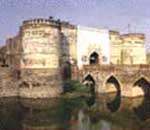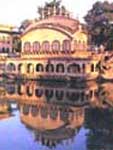| |
|


Alwar
has been among the historic cities in Rajasthan.
It is surrounded by prehistoric as well as historic
sites that are an archaeologist's delight. Once
a part of the Matsya kingdom, a visit to Alwar
is like walking back into the past. This area
is protected from the desert sands by the Aravalli
range that also provides Alwar with a lot of
picturesque locations. The entire region is
rich in lakes and wooded hills that provide
shelter to a large variety of flora and fauna.
Today,
Alwar is an important industrial centre and
one of Delhi's satellite towns yet its ancient
temples, medieval forts and palaces, gardens
and wildlife make it and interesting tourist
destination. Some important sights that are
not to be missed are the Bala Qila where Emperor
Babur spent one night ,the majestic City Palace
which houses a museum can be found quite a few
of Alwar's legendary treasures - rare manuscripts,
paintings, objects made from jade, ivory and
silver and a large collection of weapons.
The
beautiful Moosi Maharani ki Chhatri is a majestic
red sand stone and white marble cenotaph built
in the memory a mistress of maharaja Bhaktawar
Singh, a ruler of Alwar.
|
|
|
|
Other interesting monuments are Vinay Vilas Palace
, Vijay Mandir Palace and Moti Doongri. A little further
on the road to Jaipur is Alwar's most popular picnic
spot - Siliserh. Built as a summer resort , it is
a delightful little palace overlooking a tranquil
lake and surrounded by hills. To the west lies the
protected forests of Sariska. Once the hunting grounds
of the ruler of Alwar, the Sariska Tiger Reserve and
Wildlife sanctuary today provides shelter to a large
variety of wildlife which includes sambhar, chinkara,
wild boar, jackal, and the elusive tiger. Several
species of birds are also found here. The forests
area of Sariska is replete with relics of the past.
To the west lies Viratnagar. a city revered in history
of having given shelter to the mighty Pandava brothers
of Mahabharata.
|
|
Explore the forests for temples
even rock formations that have some association with
the past. It is also one of the oldest historical
sites in Rajasthan. An edict of King Ashoka the Great
dating back to the 3rd century was found here. In
another part of the site are the ruins of a circular
Buddhist temple, considered to be the earliest free
standing structures of India.
|

Lohagarh
Fort
|
|
Sariska
Palace
|
There
are many places in this region which once
visited will be remembered for ever.The
palaces and temples of Deeg are among the
most beautiful in this region.Being closer
to Agra and Delhi, the Mughal influences
were stronger here.
|
This
small town has the most well laid out gardens and
palace pavallions.The Gopal Bhawan, Nand Bhawan
and Krishan Bhawan are ingeniously designed palaces
that have attractive features and are rich in history.
A visit to this region is not complete without a
trip to Bharatpur.The history of Bharatpur traces
the rise and fall of Jat power in eastern Rajasthan.
This was the region where important
Jat rulers like Churaman, Badan Singh and Suraj
Mal dominated the history of this entire belt. They
fought the invading Marathas, Mughals and the interfering
British and were a power to reckon with and strong
enough
|
to
lay down their own terms and conditions.
The fort of Bharatpur is the focal point
of the city. It took sixty years to build
it and it is known as the Lohagarh or the
Iron Fort. Today the fort is partly used
by the government offices and a large part
of it houses the government museum. Keolado
National Park, once the hunting preserve
of princes of Bharatpur, is today ranked
among the world's best bird sanctuaries.Every
year this is visited by over 400 species
of water birds which include exotic migratory
birds from Afganistan,
|
 Deeg
Palace
Deeg
Palace |
Central
Asia, Siberia and Tibet. The greylag and barhead
geese are among the important visitors but the star
of the sanctuary is the rare Siberian crane. If
you're a bird lover, then this is your paradise,
but even if you just have a passing interest in
birds you cannot fail to be impressed by the mind-boggling
variety of birds that arrive in this park.
The stone of Dholpur is famous in the country and
has been used for the construction of many a fort
and palace not only in Rajasthan but in Agra, Delhi
and other states as well. You can pick up small
mementoes
|
|

Vinay
Vilas Palace
|
from the markets. Dholpur
in itself does not seem to have too many tourist
attractions but the areas surrounding Dholpur are
important for their historicity. Jhor was the site
of the oldest Mughal garden built by Babur in 1527
and rediscovered in the 1970's there is the famous
Machkund where a religious fair
|
every
year sees a gathering of devotees seeking a cure for their
skin ailments after a dip in the holy kund. Other important
areas include Bari and Damoh and the Van Vihar and Ram Sagar
Sanctuary.
The other area of international importance is the tiger
land of Ranthambhor. Ranthambhor needs little introduction
as it is one of India's conservation success stories. This
is the ideal place in Rajasthan to see the Indian tiger
in its natural habitat. Lush green forested hills, lakes
inside the National Park, lodges and water holes; Ranthambhor
is a different world altogether. Don't come to Ranthambhor
as a tourist, let the wild life enthusiast in you take over
and just allow yourself to be guided by the jungle atmosphere.
If you can pull yourself out of the Ranthambhor forest,
don't miss the formidable fort of Ranthambhor which has
a popular Ganesh Temple. A little further is the unusual
Sunheri Kothi of Tonk. It is possible to pick up felt rugs
called namdas and leather stuff from Tonk.
|
|
|



